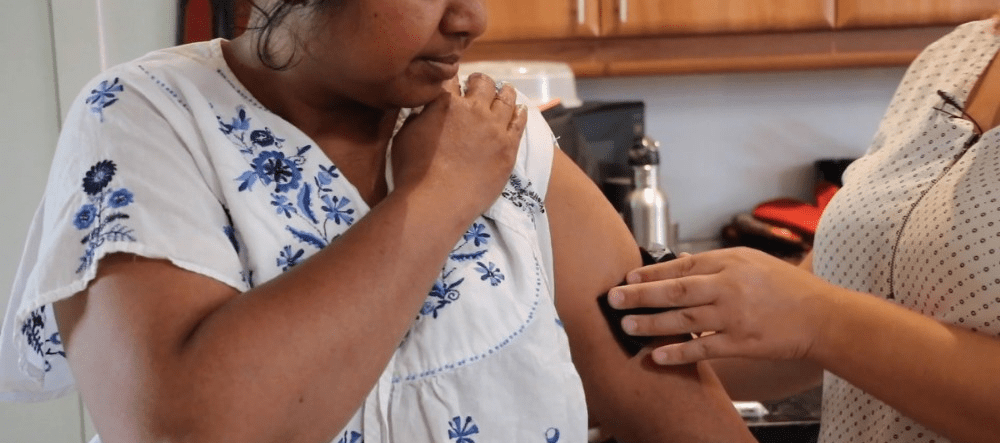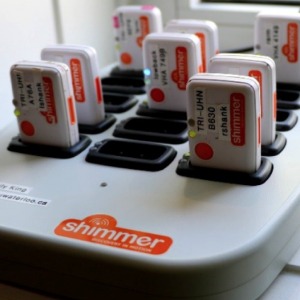Biometric Research Aims to Reduce Personal Support Workers Injuries

Personal support work is a physically demanding job. Repeated bending, lifting and stretching are all part of a day’s work and, in addition to the potential for sudden acute injuries, “There are cumulative injuries that can happen,” says Emily King, VHA’s new Manager of Research Operations, who is also a postdoctoral fellow in Kinesiology at the University of Waterloo. “Tiny bits of damage—not really noticeable externally—accumulate over time and weaken the back, for example, leading to chronic pain.”
Emily is leading a new VHA-University of Waterloo collaborative research project aimed at reducing work-related Personal Support Worker (PSW) injuries. “PSWs get hurt a lot. Back pain is very common for them. The environments PSWs work in aren’t set up for caregiving—they are people’s homes—which can make it hard to provide care sometimes,” Emily explains. The fact that this care is being provided in private homes also makes it more challenging to reduce injuries. “Other care providers are typically not around, so often no one will notice if a PSW moves their body in a damaging way. The goal of this research is to try to capture the movements the PSW’s body is making as they provide regular care.”
The study has been designed with privacy in mind. There are no cameras in the client’s home and no personal health information is collected. “Our focus is solely on PSW movement,” says Emily.
The study uses movement sensors called Inertial Measurement Units that are attached to the PSW’s arms, upper and lower back, thighs and lower legs to track the body’s motion. Each sensor tracks two modes of data: how fast it is moving in each direction and the acceleration.
Emily arrived at the placement array for the sensors in collaboration with VHA PSWs. “I was chosen as a PSW advisor for Emily,” says Latha Jaya, a VHA PSW who has been supporting Emily’s work. “Emily used the sensors on me to find out if they fit my body properly and whether I’m able to deliver proper care for the clients with the sensors on. My feedback is helping her to improve the project.”
Research in Action
PSWs who choose to participate in the research meet Emily at an off-site location near a client’s home prior to a care visit. After completing surveys about how they are feeling that day and a bit about their personal background, PSWs are fitted with the sensors and conduct a brief set of movement exercises to ensure comfort, to orient the sensors, and to synchronize the sensor data before leaving to care for the client.

After providing care, the PSW returns to Emily. “We process the data from the sensors and we have a little stick figure that shows how the PSW’s body was moving through the visit. The PSW will look through what the stick figure is doing over time and help us identify what activities they were doing at that point in the visit, such as, ‘Oh yes, that’s when I was helping them to get out of bed’, or ‘that’s when we were getting the client dressed.’ If we can estimate the postures of the PSWs, then we can work out whether they are in postures that have been linked to musculoskeletal injuries,” explains Emily.
This phase of the research comes after many steps to develop the research protocol. The study went through a thorough research ethics process to ensure it balanced risks and benefits appropriately. Emily then focused on making sure the sensor system worked properly. “We’ve been running a validation study in a lab at the University of Waterloo and things are looking good, which leads to the next exciting phase: taking this into the home,” she adds.
This research has the potential to answer numerous questions about how PSWs are getting injured. “We believe we have set up a very effective, long-term protocol. There is so much variation in client spaces, client conditions, how PSWs approach providing care… so to understand it all we need to collect a lot of data.” The research might shed light on such unknowns as which client characteristics are likely to mean that providing care carries a greater risk for the PSW. Or how much variation there is in providing care to the same client over different days or by different caregivers.
“From [the data] we may be able to work out better ways to train people so they can provide excellent care in a way that is safer for them. Such as, are there ways of bathing people that are riskier to a caregiver’s body?” says Emily.
VHA and Emily share the same motivation for pursuing this research: “PSWs are trained, valuable, and caring, and they have a lot of special skills they bring to the job. When a PSW is injured, we lose all of that experience and ability, which is incredibly sad. It affects their ability to make a living and their quality of life. We want to prevent those injuries to allow them to continue to do well and to be able to continue to provide care to the clients we know they care so much about,” she says.
To learn more about Emily’s research and how we are working to reduce PSW injuries, watch our video at: https://bit.ly/2ME1AHx. This project has been funded by CRE-MSD, MITACS Accelerate, a CIHR Fellowship and VHA’s Ideas2Innovations.
